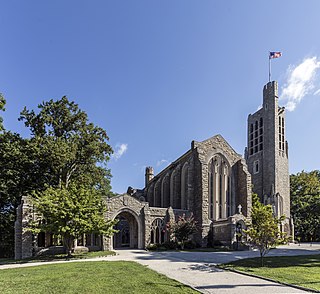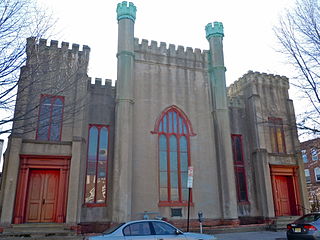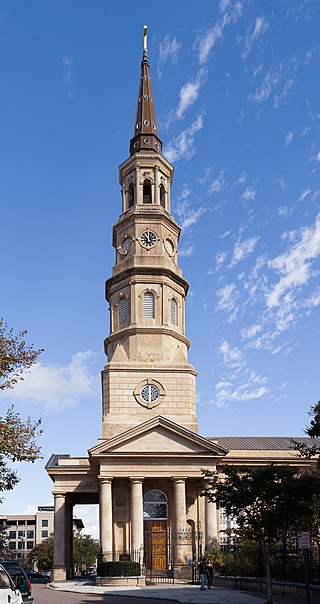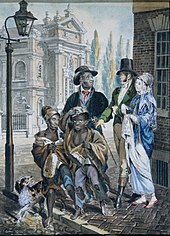
John Henry Hobart was the third Episcopal bishop of New York (1816–1830). He vigorously promoted the extension of the Episcopal Church in upstate New York, as well as founded both the General Theological Seminary in New York City and Geneva College in Geneva in the Finger Lakes area. He was the beloved pastor of Elizabeth Seton before her conversion to Catholicism.

Christ Church Burial Ground in Philadelphia is an important early-American cemetery. It is the final resting place of Benjamin Franklin and his wife, Deborah. Four other signers of the Declaration of Independence are buried here, Benjamin Rush, Francis Hopkinson, Joseph Hewes, and George Ross. Two additional signers of the Declaration of Independence, James Wilson and Robert Morris, are buried at Christ Church just a few blocks away.

The Reformed Episcopal Church (REC) is an Anglican church of evangelical Episcopalian heritage. It was founded in 1873 in New York City by George David Cummins, a former bishop of the Protestant Episcopal Church.

William White was the first and fourth Presiding Bishop of the Episcopal Church of the United States, the first bishop of the Diocese of Pennsylvania (1787–1836), and the second United States Senate Chaplain. He also served as the first and fourth President of the House of Deputies for the General Convention of the Episcopal Church.

Samuel Provoost was an American Clergyman. He was the first Chaplain of the United States Senate and the first Bishop of the Episcopal Diocese of New York, as well as the third Presiding Bishop of the Episcopal Church, USA. He was consecrated as bishop of New York in 1787 with Bishop William White. He was the first Episcopal Bishop of Dutch and Huguenot ancestry.

The Episcopal Diocese of New York is a diocese of the Episcopal Church in the United States of America, encompassing three New York City boroughs and seven New York state counties. Established in 1785, it is one of the Episcopal Church's original dioceses. The current diocesan bishop is the Rt. Rev. Andrew Dietsche, whose seat is at the Cathedral of Saint John the Divine; the Rt. Rev. Matthew Heyd was consecrated as bishop coadjutor in 2023 and will succeed Dietsche as diocesan bishop in 2024.

Washington Memorial Chapel in Valley Forge National Historical Park is a national memorial dedicated to General George Washington and an active Episcopal parish in Valley Forge, Pennsylvania. The church was inspired by a sermon preached by Anglican minister Reverend Dr. W. Herbert Burk, founder and first rector of the parish. The building was designed by architect Milton B. Medary. It was listed on the National Register of Historic Places on May 1, 2017, and is undergoing an active restoration campaign.

St. Peter's Church is a historic Episcopal church located on the corner of Third and Pine Streets in Philadelphia, Pennsylvania. It opened for worship on September 4, 1761 and served as a place of worship for many of the United States Founding Fathers during the period of the Continental Congresses. The building was designated a National Historic Landmark in 1996. The church remains an active parish; the current priest-in-charge is the Rev. Dr. Clarke French.

Established in 1703, St. Michael's Church in downtown Trenton, Mercer County, New Jersey, United States, is a founding parish of the Episcopal Diocese of New Jersey. Its present building located at 140 North Warren Street was built in 1747–1748, and was renovated in 1810 and 1847–1848. It was listed on the National Register of Historic Places on April 29, 1982 as St. Michael's Episcopal Church.

Thomas John Claggett was the first bishop of the newly formed American Episcopal Church to be consecrated on American soil and the first bishop of the recently established (1780) Diocese of Maryland.

Edward Bass was the first American Episcopal bishop of the Diocese of Massachusetts and second bishop of the Diocese of Rhode Island.

Christ Episcopal Church is an Episcopal congregation in South Pittsburg, Tennessee, part of the Episcopal Diocese of East Tennessee. The church building and parish house, located at 302 West 3rd Street, are listed on the National Register of Historic Places.

St. Philip's Church is an historic church at 142 Church Street in Charleston, South Carolina. Its National Historic Landmark description states: "Built in 1836, this stuccoed brick church features an imposing tower designed in the Wren-Gibbs tradition. Three Tuscan pedimented porticoes contribute to this design to make a building of the highest quality and sophistication." On November 7, 1973, it was added to the National Register of Historic Places and designated a National Historic Landmark.

Old Trinity Church, also known as Trinity Church, Oxford, is a historic Episcopal church established in 1696 located in Oxford Township, Pennsylvania, which is now part of Philadelphia.

The Church of St. James the Greater is an Episcopal church located in the heart of the Bristol Historic District in Bristol Borough, Pennsylvania. It is part of the Episcopal Diocese of Pennsylvania and the Episcopal Church in the United States of America.

The Church of the Epiphany was an Episcopal congregation in Philadelphia, Pennsylvania. Founded in 1834, it merged with St. Luke's Church in 1898 to form The Church of St. Luke and the Epiphany. Its 1834 Greek Revival building, designed by architect Thomas Ustick Walter and located at 1501-15 Chestnut Street, was demolished in 1902.

Jonathan Gostelowe was an 18th-century American cabinetmaker, best remembered for his Philadelphia Chippendale-style furniture.

Christ Church, also known as Christ Episcopal Church, is a Christian house of worship located on the corner of Church Street and Main Street in Newton, New Jersey. It is a parish overseen by the Episcopal Diocese of Newark, a diocese of the Episcopal Church in the United States of America. The congregation first met on 28 December 1769 and was granted a charter by New Jersey's last Royal Governor William Franklin on behalf of Britain's King George III. Christ Church is the oldest church in Newton and the third oldest parish in the Diocese of Newark.

Christ Church is an Episcopal church at 28 Bull Street, Johnson Square, in Savannah, Georgia. Founded in 1733, it was the first church established in the Province of Georgia and one of the first parishes within the Episcopal Diocese of Georgia, earning it the nickname "the Mother Church of Georgia". The present church building was constructed in 1838 and is located in the Savannah Historic District.






























